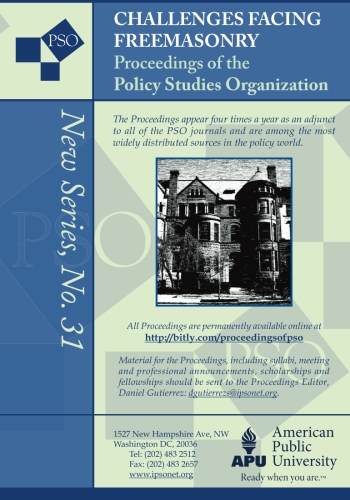by John L.L. Cooper III, Preface by Paul J. Rich
Purchase through Amazon | Purchase on CreateSpace
Secrecy and ritualism often go together, although for many societies the secrecy is no longer as strong as it once was. However, ritual remains one of their major characteristics, making them distinct from a large number of other groups that may have a few ceremonies such as passing along the chair’s gavel or investing new members with lapel pins but which are chiefly issue-oriented. Sometimes it is hard to demar cate between a ritualistic and issue-oriented movement. While the Grange, for example, is certainly an agricultural lobby, it has always had a strong ritualistic side. Rotary or the Lions would seem to be more on the service side, but we have all met members who were as enraptured by the Rotary Wheel as anyone ever was by the Masonic square and compass. All of this presents special challenges to understanding.
cate between a ritualistic and issue-oriented movement. While the Grange, for example, is certainly an agricultural lobby, it has always had a strong ritualistic side. Rotary or the Lions would seem to be more on the service side, but we have all met members who were as enraptured by the Rotary Wheel as anyone ever was by the Masonic square and compass. All of this presents special challenges to understanding.
As Dr. Cooper points out, there can be a change in emphasis over the years. But for all the changes, few public or university libraries take seriously the collecting of material on the Masons, so the serious researcher must get permission to use Masonic archives and libraries. A number date from the nineteenth century and have large holdings. An idea of what they might contain is indicated by the classifications of the Library of the Supreme Council of the Scottish Rite in Washington, which dates back to 1888 and even then had more than eight thousand volumes. Categories include philosophy and symbolism, church and state, paraphernalia, glassware, benevolent and educational institutions, hospitals, cemeteries, architecture, poetry and drama, humor and satire, and women in Masonry. Paris is unique in having at least four major collections.
Another challenge is understanding the special language and usages that an organization such as the Masons invokes. The more ritualistic the society, the more arcane will be the terminology found in papers. As an example, a considerable problem for the researcher is the dating system used by different Masonic bodies. Ordinary Craft or blue lodge Masons who have taken the first three degrees of Entered Apprentice, Fellowcraft and Master Mason use the Anno Lucis system, adding 4000 years and giving the year as dated from the Creation. Thus a blue lodge Masonic document of 1995 would be 5995. Royal Arch Masons begin the calendar with the start of work on the Second Temple at Jerusalem in 530 B.C., so that this is the year 2525. Royal and Select Masters number the years from the completion of the original King Solomon’s Temple in 1000 B.C., making this the year 2995. Masonic Knights Templar date documents from the founding of the Order in 1118 and hence this is 877. There are other pitfalls: On occasion the researcher will face documents that have been rendered into cipher or have had critical words removed. He or she will also encounter vast amounts of allegory and metaphor, so that without an advance immersion in the rituals the text will be unintelligible.

